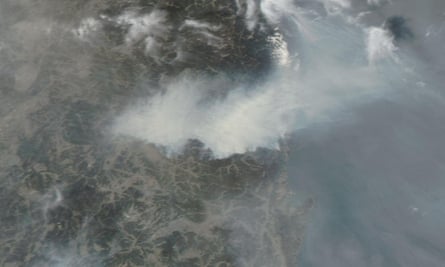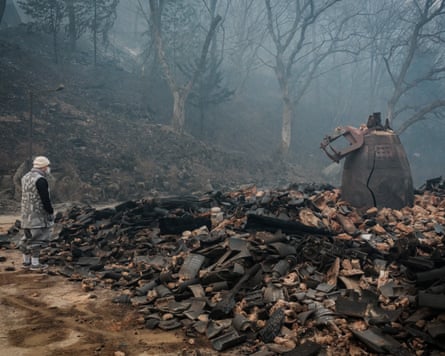South Korea wildfires spread to become biggest on record as death toll reaches 26
March 26, 2025
Wildfires raging in South Korea doubled in size in a day, as authorities on Thursday called the blazes the country’s worst ever natural fire disaster with at least 26 people killed and historic temples incinerated.
More than 33,000 hectares (81,500 acres) have been charred or were still burning in the largest of the fires, which began in the central Uiseong county, making it the biggest single forest fire in South Korea’s history.
“We are nationally in a critical situation with numerous casualties because of the unprecedented rapid spread of forest fires,” the acting president, Han Duck-soo, told a government response meeting.
The military has released stocks of aviation fuel to help keep firefighting helicopters flying to douse flames across mountainous regions in the south-east of the country, where fires have been burning now for nearly a week. More than 300 structures had been destroyed, officials said.
As of Thursday morning, authorities were mobilising more than 9,000 people and about 120 helicopters to battle the fires, the government’s disaster response centre said.
The country’s disaster chief said the wildfires were now “the largest on record”, having burned more forest than any previous blazes.
“The wildfire is spreading rapidly,” Lee Han-kyung said. “The forest damage has reached 35,810 hectares, already exceeding the area affected by the 2000 east coast wildfire, previously the largest on record, by more than 10,000 hectares.”

The fatalities include a pilot whose helicopter crashed during efforts to contain a fire and four firefighters and other workers who died after being trapped by fast-moving flames driven by strong winds.
Authorities have not disclosed details of the civilian dead, except that they are mainly in their 60s and 70s. They suspect human error caused several of the wildfires that began last Friday, including cases where people started fires while clearing overgrown grass from family tombs or with sparks during welding work.
The blazes were threatening two Unesco world heritage sites – Hahoe Village and the Byeongsan Confucian academy – in Andong city on Wednesday, a city official said, as authorities sprayed fire retardants to try to protect them.
Andong and the neighbouring counties of Uiseong and Sancheong, as well as the city of Ulsan, have been hardest hit. On Wednesday night, strong winds and smoke-filled skies forced authorities in Andong, in the south-east, to order evacuations in two villages, including Puncheon, home to the Hahoe folk village, founded around the 14th-15th century. Hikers were advised to leave the scenic Jiri mountain as another fire spread closer.
The wildfires originated in Uiseong and have been moving rapidly eastward, spreading almost to the coast, carried by gusty winds and with dry conditions aggravating the situation.
The meteorological agency has forecast some rain for the south-west but precipitation is expected to be under 5mm for most of the affected areas.
“The amount of rain is going to be small so it doesn’t look like it’ll be big help in trying to extinguish the fire,” said the Korea Forest Service minister, Lim Sang-seop.
Officials said earlier this week that firefighters had extinguished most of the flames from the largest wildfires in key areas, but wind and dry conditions allowed them to spread again.
Destroyed in the blazes were houses, factories, vehicles and some historic structures. In Uiseong, about 20 of the 30 structures at the Gounsa temple complex – which was said to be originally built in the 7th century – have been burned. Among them were two state-designated “treasures” – a pavilion-shaped building erected overlooking a stream in 1668, and a Joseon dynasty structure built in 1904 to mark the longevity of a king.

The Korea Forest Service has raised its wildfire warning to the highest level, requiring local governments to assign more workers to emergency response, tighten entry restrictions for forests and parks and recommend that military units withhold live-fire exercises.
Experts have said the Uiseong fire showed extremely unusual spread in terms of its scale and speed, and that climate change was expected to make wildfires more frequent and deadly globally.
Higher temperatures amplified by human-caused climate change contributed to the existing seasonally dry conditions, “turning dry landscapes into dangerous fire fuel” in the region, said the Climate Central group, an independent body made up of scientists and researchers.
With Reuters, Associated Press and Agence France-Presse
Search
RECENT PRESS RELEASES
Related Post




